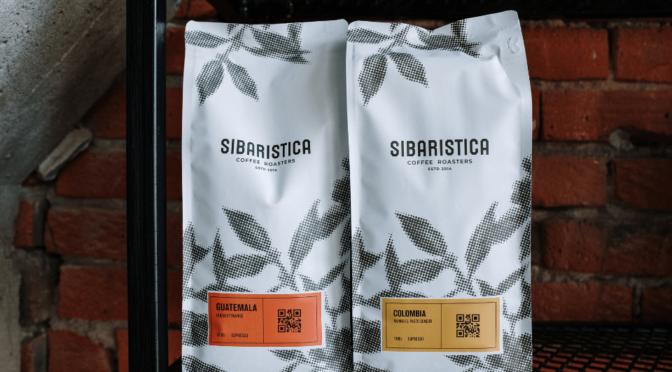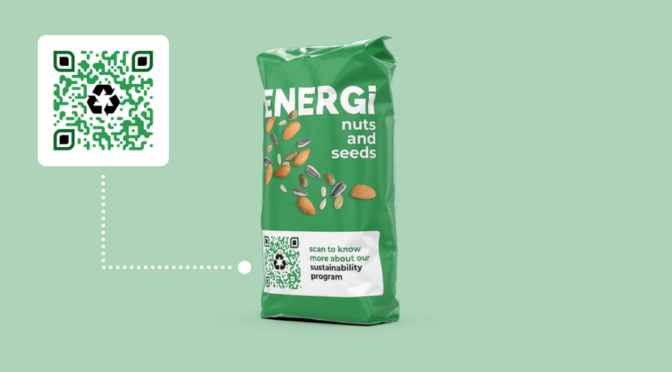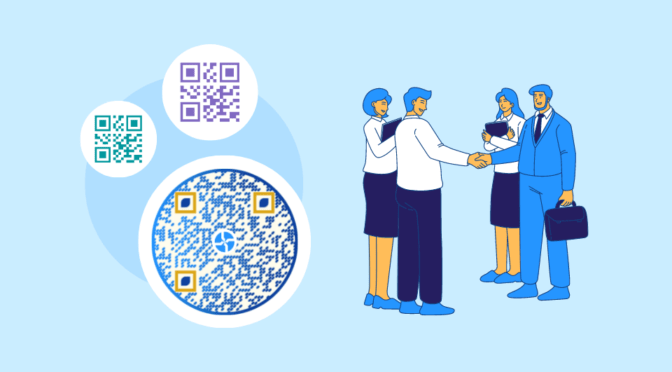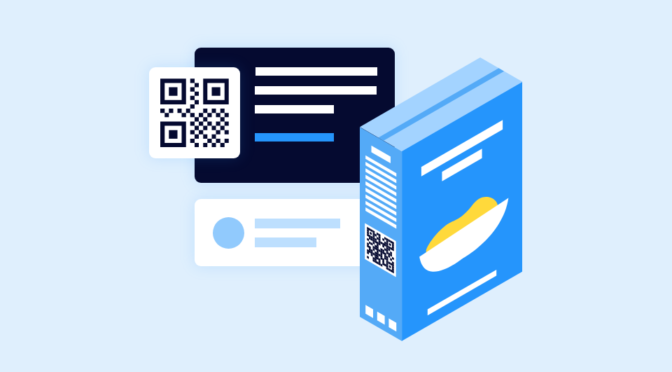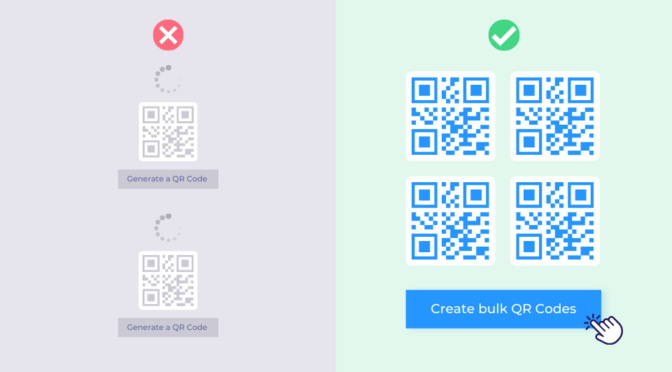Your shelves are stocked with hundreds of products, each one fighting for attention. Customers want to know more. They want to see if the ingredients align with their diet. They want to understand what makes this brand different from the five others sitting right next to it, and they want a reason to buy it again. But the label can’t hold all that without becoming a cluttered mess.
Here, we’re facing the problem of limited labels vs. unlimited information.
QR Codes solve this. One small square on packaging becomes unlimited digital space for product information, support videos, authentication checks, loyalty programs, analytics and more.
At Uniqode, we help brands like Nestlé, White Claw, and Monster Energy transform their packaging into connected touchpoints, making every product scannable, trackable, and actionable. (Humble brag: Uniqode is rated the highest amongst all QR Code generators on G2)
This guide draws from those experiences, plus conversations with packaging directors dealing with EU compliance deadlines, operations teams managing millions of products, and yes, the executives who had to justify the investment. Their stories, both wins and failures, shape every recommendation here.
Table of Contents
- What is connected packaging?
- 10 ways retailers use QR Codes on packaging today
- Packaging gaps that cost retailers (+ how QR Codes can fix them)
- Best practices for QR Codes on product packaging to boost sales and revenue
- Why GS1 QR Codes matter for retail and product packaging
- Turn every package into a digital sales channel with Uniqode
- Frequently asked questions
What is connected packaging? A no-nonsense definition
Connected packaging transforms product labels into two-way communication channels using QR Codes. The QR Code itself is a simple technology. The transformation happens when companies realize packaging can now collect data, update content dynamically, and measure engagement—things that were impossible with static labels or static QR Codes.
Here’s what customers are using packaging QR Codes for: A Global Retail Corporation couldn’t fit multilingual installation instructions on their plumbing products sold through their retail stores. One QR Code now delivers instructions in any language, plus warranty info and spec sheets. One of the largest beverage innovation companies in the United States tracks where customers buy their beverages and retargets them with seasonal promotions. A pharmaceutical company in Lebanon uses serialized QR codes to fight counterfeits.
The pattern is consistent: companies start with one problem (usually space constraints or compliance), then discover that packaging QR Codes solves multiple challenges they didn’t know they could address.
QR Codes on packaging started off as a novelty, something along the lines of a tech gimmick that most shoppers ignored. Early adopters slapped them on boxes with no clear purpose, linking to generic homepages or PDFs.
That has changed. QR Codes on packaging now act as a direct bridge between the physical product in a shopper’s hand and the digital experience they expect. You can take a shopper to a destination in seconds, from nutritional details to AR try-ons. For businesses, the package stops being static and becomes a conversion tool that collects first-party data.
Let’s look at how QR Codes have evolved in the retail industry:

What makes the difference isn’t the QR Code graphic itself but what it can do: integrations, analytics, and personalization. This is where your packaging stops being a label and starts working as a digital sales channel.
10 ways retailers use QR Codes on packaging today
Throughout most of this piece, we’ll be talking specifically about customer-facing implementations. Technically, though, a packaging QR Code can serve multiple functions, from supply chain tracking to checkout scanning to customer engagement.
Here’s what’s actually happening on shelves right now:
1. Set up guides and warranty registration
Customers return products when paper manuals go missing or instructions are confusing. You can solve this by printing multiple QR Codes on packaging—two linking to setup guides and one to warranty registration.
These QR Codes are your first line of customer support. Major electronics brands report 40% fewer support calls when packaging links directly to setup videos. Managing these resources means happier customers and lower operational costs.
Examples: Electronics, furniture, appliances
2. Nutrition details and recipes
Food labels are cramped, and nutrition tables rarely tell the whole story. Brands like Nestlé use QR Codes on food packaging to meet EU labeling standards, linking to detailed ingredient information.
The Whole Truth takes it further by using QR Codes on protein bars that reveal lab test results for every ingredient.
Similarly, Hello Tempayy uses QR Codes on its meal packs to share chef-created video recipes—turning packaging into a mini cooking assistant.
Some FMCG brands also add recipe libraries, so a cereal box doesn’t just inform, it inspires, which results in better shopper confidence and larger baskets.
Examples: Nestlé, Kellogg’s, major CPG brands
3. Authentication and anti-counterfeit
Counterfeit products are a revenue and trust killer in pharma, supplements, and luxury. Serialized QR Codes printed directly on packaging let customers verify authenticity instantly. You protect margins and safeguard brand reputation, while customers feel reassured that their product is genuine.
Maesa, a beauty incubator brand, uses Uniqode’s dynamic QR Codes to share Certificates of Analysis for its cannabis-infused lineup, ensuring regulatory compliance and consumer confidence.
This practice not only builds credibility but also reduces counterfeit risks.
Examples: Pharmaceutical companies, luxury brands, supplement manufacturers
4. Store discovery
Packaging can double as a store locator. Haldiram’s, an Indian snack brand that also has restaurant franchises, prints QR Codes on snack packs that guide customers to the nearest outlet.
Instead of relying on billboards or ads, you can use packaging itself to funnel customers into physical locations.
Examples: Haldiram’s restaurant finder, retail locations
5. Promotions and campaign engagement
Seasonal campaigns often outpace the print cycles. You can extend campaign life without reprinting costs using dynamic QR Codes which allow you to change the destination of a QR Code without having to change how the QR Code appears, meaning you will not have to reprint or reshare the QR Code. The same QR Code will now point to your new campaign.
CPG brands can use QR Codes quite creatively. Coca-Cola uses dynamic QR Codes on bottles that rotate between offers, discounts, and event access. Kellogg’s has tested QR Codes on cereal packs that connect shoppers to promotions and digital experiences.
Wendy’s famous “Sip & Scan” campaign used QR Codes on cups and bags to unlock free food offers, driving a surge in app downloads and repeat visits.

Retailers can replicate this by rotating QR Code destinations seasonally, say, from “summer sale” to “holiday offers”, without reprints.
⚡Pro Tip: Generate thousands of unique QR Codes at once
Do you need thousands of unique campaign QR Codes? Uniqode’s bulk generation simplifies mass creation, so you can easily scale seasonal offers across packaging.
6. Recycling and aftercare information
Eco claims mean little without guidance. Clos du Bois wines added QR Codes to bottles that direct U.S. customers to recycling instructions.
You gain measurable eco-credibility, while customers appreciate clear action steps.
7. Reviews and social proof
Reviews drive sales, but nudging customers to leave a review is tricky. Imagine a snack brand adding a QR Code on its chip packet that takes buyers straight to a one-tap review form. Or a sparkling water label with a QR Code that unlocks an Instagram AR filter where shoppers can say “cheers” with friends.
The timing matters: packages get scanned when satisfaction is highest, right after consumption. Instead of hoping customers remember to review later, you’re capturing feedback when the package is in their hands and satisfaction is at peaks.
8. Cross-sells and upsells
Why stop at a single purchase? Picture a coffee brand putting a QR Code on its takeaway cup that leads to a curated store of beans, subscription offer, brewing kits, and recipes. Or a pet food bag with a QR Code that lists ingredients and links to a training tips app.
Suddenly, packaging is a storefront helping you nudge repeat purchases and unlock new revenue streams without extra shelf space.
9. Entertainment and AR experiences
Packaging can now delight as much as it informs. Pizza Hut’s “Newstalgia” boxes featured QR Codes that launched an AR Pac-Man game, while Cinemark turned Gladiator II popcorn buckets into AR battle arenas.
These campaigns kept customers engaged long after consuming the product, giving you brand buzz and loyalty without extra spending.
10. Beauty tutorials and app downloads
In personal care, QR Codes add an extra layer of value. Global beauty brands now use QR Codes to link packaging to tutorials, sustainability insights, and app ecosystems, creating repeat engagement opportunities long after purchase.
You gain a product sale and an entry point into a larger digital ecosystem.
Pupford, a pet training brand, has made app downloads accessible by placing QR Codes on their packaging. When customers scan the code, they can download Pupford’s training app, which offers tutorials and other valuable resources
Packaging gaps that cost retailers (+ how QR Codes can fix them)
Despite billions spent on packaging design, there are cracks everywhere in the customer journey. These gaps don’t just frustrate shoppers; they translate into missed sales, higher return rates, and lost loyalty for retailers.
Pre-purchase: When packaging creates hesitation
A shopper picks up a cereal box. The design stands out, but the label can only fit the ingredients. It misses allergy details, recipes, or where things are sourced. The shopper moves on without clarity, leaving you with unsold stock and slower shelf turnover.
What’s the issue for retailers?
- Limited labels mean shoppers walk away uncertain, which drives down conversion rates.
- Missed opportunity to highlight brand values like sustainability or sourcing.
How QR Codes help:
One scan provides nutritional breakdowns, allergy warnings, recipes, and sourcing information without redesigning packaging. This clarity reduces people walking away, builds trust, and helps retailers move products faster while minimizing shelf abandonment.
⚡Pro Tip: Turn hesitation into action
See where shoppers pause and why. With Uniqode’s analytics dashboard, track scans by region, product, and time to uncover patterns in real-world behavior. Use these insights to fine-tune shelf placement, cut stock abandonment, and drive more conversions.
During purchase: When engagement falls flat
A customer is ready to buy, but the packaging does not directly link to promotions or loyalty programs. Seasonal offers are missed, and regional campaigns can’t sync with static printing. You invest heavily in promotions but see little conversion at the shelf.
What’s the issue for retailers?
- Static print cycles make campaigns costly and slow to adapt.
- Promotions often miss the moment of intent.
- Loyalty spend is underutilized when packaging doesn’t connect directly.
🧠 Pro tip: Integrate Uniqode’s dynamic QR Codes with Zapier to automate customer trigger notifications.
Once you connect your account, you can set triggers that activate whenever a QR Code on the product package is scanned.
Zapier will automatically send predefined messages to customers based on the triggers you define.
Use this to increase direct and indirect interactions between your brand and customers, creating a seamless and engaging experience.
How QR Codes help:
Dynamic QR Codes let you rotate promotions instantly, link shoppers to loyalty programs in real time, and adjust offers by location or time of day. Packaging becomes a conversion tool that maximizes ROI on marketing and loyalty investments.
Post-purchase: When packaging goes silent
Once a product leaves the store, the packaging does nothing more. Customers struggle with missing manuals or warranty registrations. For you, that means rising support costs and a risk to brand credibility.
What’s the issue for retailers?
- No feedback loops = lost first-party data and missed upsell opportunities.
- Poor product support leads to expensive service calls.
How QR Codes help:
QR Codes extend packaging beyond the sale. You can deliver digital manuals, warranty activation, re-order portals, and authentication features. This reduces support costs, prevents counterfeits
Best practices for QR Codes on product packaging to boost sales and revenue

Static packaging has limits; it can only carry so much before it looks cluttered or confusing. That’s why retailers across industries are turning to QR Codes to extend packaging into a digital channel.
Here’s how it plays out by sector:
1. Consumer electronics
What’s the issue: Electronics packaging can’t fit complex setup guides, multilingual manuals, or warranty steps, which often leads to confusion and returns.
How to fix this: Add QR Codes linking to digital manuals, quick-start videos, and warranty registration pages so customers can access information instantly without paper clutter.
Ikea’s Mobile Checkout experience is a perfect example of how QR Codes streamline customer journeys, letting users scan, pay, and skip queues. Similarly, electronics retailers can apply QR Codes for setup tutorials, manuals, or product registration, reducing returns and increasing customer satisfaction.
📌Creative QR Code applications:
- Personalized onboarding portals: A scan opens a tailored dashboard with tutorials, software downloads, and region-specific offers. For you, this cuts down setup errors and reduces return risk.
- Easter-egg style upgrades: Hidden QR Codes on packaging unlock extended warranties or bonus accessories. Customers feel rewarded, and you can build brand love that keeps buyers coming back.
2. Food & beverage (CPG)
What’s the issue: Limited shelf space means brands can’t communicate nutrition details, sourcing, or recipes effectively, leading to hesitation at the point of purchase.
How to fix this: Use QR Codes to share nutritional transparency, recipe inspiration, and seasonal campaign tie-ins.
📌Creative QR Code applications:
- Interactive flavor journeys: Scans unlock playlists, mood-based recipes, or cocktail pairings. You keep seasonal SKUs fresh and encourage repeat buying.
- Collect-to-win challenges: Each pack unlocks part of a digital puzzle that customers complete for rewards, shifting engagement from one-off to continuous.
- Behind-the-scenes storytelling: QR Codes reveal farmer stories or sustainability projects, helping you justify premium pricing with authenticity.
⚡Pro Tip: Seasonal campaigns that never expire
Tie codes to Uniqode Smart Rules so the same cereal box can rotate from “summer recipes” to “holiday offers” automatically. Fresh campaigns, no reprints.
3. Pharma & healthcare
What’s the issue: Counterfeit medicines, vague dosage instructions, and overwhelming leaflets increase compliance risk and customer frustration.
How to fix this: Add QR Codes for dosage videos, authentication checks, and links to safety information.
Maesa’s use of QR Codes for compliance documentation shows how powerful transparent QR integrations can be in regulated spaces. Healthcare and pharma brands can adapt this model to link dosage instructions, authentication checks, and patient education videos.
📌Creative QR Code applications:
- AI-powered symptom checks: QR Codes open quick assessments before patients call helplines, easing pressure on support teams.
- Virtual pharmacist sessions: Scans connect patients to live or recorded consultations, no app required. This boosts trust and reduces misuse.
- Wellness loyalty loops: Patients earn health points every time they scan for dosage instructions, redeemable for future products, keeping customers in the ecosystem.
4. Home, DIY & appliances
What’s the issue: Printed manuals often get lost, and poor setup drives negative reviews and returns.
How to fix this: Use QR Codes for digital setup instructions, warranty registration, and reorder links for parts.
📌Creative QR Code applications:
- AR assembly guides: A scan projects the furniture or appliance assembly in real time. Customers build with confidence, and you avoid costly returns.
- Smart part recognition: Scan a broken part, and the QR Code directs to a reorder page, allowing you to unlock aftermarket revenue effortlessly.
- Community hack libraries: Codes link to user-generated hacks, like creative uses for a coffee machine. This keeps products relevant and “sticky.”
5. Fashion & apparel
What’s the issue: Sizing uncertainty, lack of styling inspiration, and sustainability concerns lead to high return rates.
How to fix this: QR Codes on tags can share size guides, styling tips, and sustainability certifications.
📌Creative QR Code applications:
- Style roulette: Each scan suggests new outfit combos using the latest season’s products, cutting styling-related returns and driving upsells.
- Sustainability passports: Codes track the garment’s journey from farm to factory to store, helping you win eco-conscious buyers.
- Collectible digital twins: Each purchase unlocks a digital certificate (like an NFT) that builds loyalty and protects against counterfeits.
6. Beverages & FMCG
What’s the issue: Promotions often expire before packaging changes, and most campaigns vanish after consumption.
How to fix this: QR Codes can host rotating promotions, gamified content, and refill offers.
📌Creative QR Code applications:
- Limited-edition AR experiences: A scan launches mini-games or exclusive concerts tied to campaigns, extending engagement long past the last sip.
- Crowdsourced flavor votes: Customers scan and vote for the next limited-edition flavor, giving you first-party data while creating pre-launch buzz.
- Surprise refill offers: Codes hidden inside caps unlock discounts for the next purchase, fueling repeat buying cycles.
7. Grocery & fresh produce
What’s the issue: Fresh produce looks interchangeable, making it hard to differentiate and command loyalty.
How to fix this: Use QR Codes for certifications (organic, fair-trade), sourcing transparency, and recipe inspiration.
📌Creative QR Code applications:
- Farm-to-fork storytelling: Scans reveal freshness timelines and farmer stories, justifying a premium price.
- Recipe builders: An avocado scan suggests recipes paired with items already in the store, boosting basket size.
- Dynamic store challenges: Each scan contributes to a local leaderboard, gamifying grocery trips and increasing repeat visits.
Across industries, QR Codes have transformed packaging into an interactive sales and engagement channel.
However, consistency and compliance become critical as adoption scales, especially when balancing retailer, regulator, and consumer needs. That’s where GS1 QR Codes come in.
Why GS1 QR Codes matter for retail and product packaging
tailers such as Walmart have relied on GS1 standards for years because every product must scan the same way at checkout. Traditional barcodes do this job well. They manage price and inventory. But they don’t help the shopper who wants instant access to allergen details, recipes, or sustainability claims.
GS1 QR Codes close that gap. They combine a barcode’s operational power with a QR Code’s consumer-facing richness.
Let’s look at an example. You’re selling a box of granola. The customer scans the GS1 QR Code at checkout, automatically updating price and stock. Later, when they scan it with their phone, they can see:
- Clear allergen and nutrition details
- Breakfast recipes using the granola
- A sustainability note showing where the oats were sourced
One code, two functions, helping both retailers and shoppers.
Here’s how GS1 QR Codes work in practice:
- At checkout: Retailers scan them like barcodes, keeping pricing and inventory seamless.
- In shoppers’ hands: The same scan reveals product information, promotions, or traceability details.
- Across borders: GS1 standards ensure the same code adapts to regional compliance rules, whether for food in Europe or pharmaceuticals in the U.S.
- For the future: With regulations like the EU’s Digital Product Passport coming, GS1 QR Codes mean brands won’t have to redesign packaging each time requirements change.
Instead of packaging doing just one job, GS1 QR Codes make it multifunctional: efficient for retailers, transparent for shoppers, and adaptable for regulators.
The future of packaging isn’t just about looking good on the shelf; it’s about carrying trusted, useful information wherever the product goes.
Turn every package into a digital sales channel with Uniqode
Without QR Codes, your customer would walk away with nothing but a list of ingredients. But with a QR Code on your packaging? You have a whole new world, where they can scan the can, unlock nutrition details, workout tips, exclusive offers, and join your loyalty program in seconds.
For you, this isn’t about slapping a square on a label; it’s about rethinking packaging as your most direct, most scalable customer touchpoint. Every product in a shopper’s hand is a chance to inform, engage, and connect.
With Uniqode, you can create dynamic QR Codes that update campaigns in real time, integrate with CRMs and loyalty systems, and capture first-party data with every scan.
Manage global packaging deployments from one dashboard, track performance, switch destinations, and stay GS1-ready without reprints.
Explore how dynamic QR Codes can turn your products into your most powerful sales channel with Uniqode.
Frequently asked questions
1. How do I get a QR Code for my product?
Use Uniqode’s QR Code generator to create a QR Code. Download the QR Code and print it to be placed on the product. We suggest placing the QR Code on the back of the visible and scannable product for easy usage.
2. What is the purpose of a QR Code on a product label?
QR Codes on product labels are mainly used to test the authenticity of the product, its origin, manufacturing process, expiration date, and any further information regarding the product.
3. How can QR Codes be used for product identification?
Place QR Codes on the products or product labels and encourage customers to scan them to be redirected to a dedicated webpage to check for authenticity and correct identification.
4. How to employ QR Codes for product tracking?
Leverage dynamic QR Codes for product tracking. Place the dynamic QR Codes on product packaging and integrate them with analytics. Every time a user scans the QR Code on the product package, the scanning location, the device used, and the scan date are tracked using analytics.
5. How to use QR Code for product information?
When scanned, QR Codes on product packaging and labels can redirect users to a landing page that contains the product’s information and insights. (For more information, see QR Code landing pages.)Want to create QR Codes for your product packaging? Sign up for our 14-day free trial today to know more.
Shashank is a content marketer at Uniqode who turned to writing to pursue his natural calling after 2+ years of working in the product team. He aims to educate folks on the brilliant yet underrated technology of QR Codes. With more than a dozen Tofu and Mofu pieces under his belt, he explores how QR Codes can be used to solve challenges for businesses across all verticals. While he’s not educating users on the benefits of QR Codes, he’s also a student of the evolving marketing landscape.
Related Posts
14 day free trial of the QR platform









